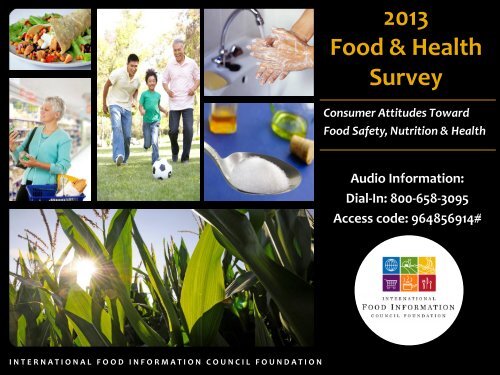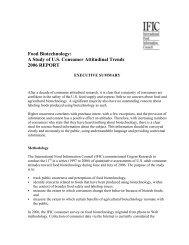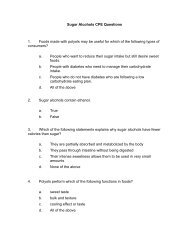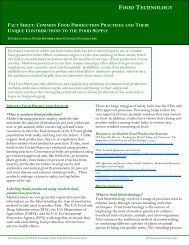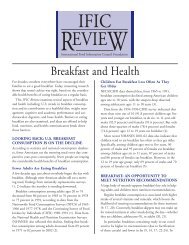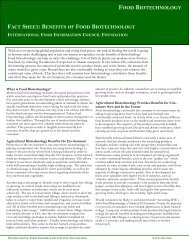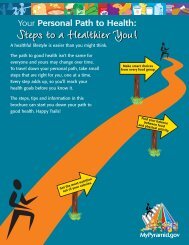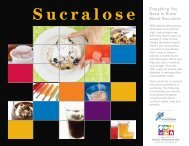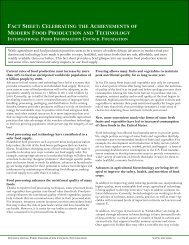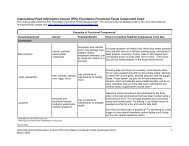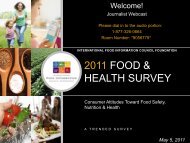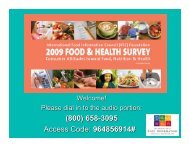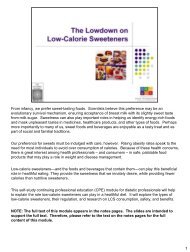to download a PDF of the slides from the presentation. - International ...
to download a PDF of the slides from the presentation. - International ...
to download a PDF of the slides from the presentation. - International ...
- No tags were found...
Create successful ePaper yourself
Turn your PDF publications into a flip-book with our unique Google optimized e-Paper software.
Today’s Team <strong>of</strong> SpeakersMarianne Smith Edge, MS, RD, LD, FADASenior Vice President, Nutrition and FoodSafetyMarcia Greenblum, MS, RDSenior Direc<strong>to</strong>r, Health & WellnessCommunicationsKris Sollid, RDAssociate Direc<strong>to</strong>r, Nutrients<strong>International</strong> Food Information Council Foundation2013 Food & Health Survey
HousekeepingDial-In Information NOTE: All lines are force-muted.Toll free number: 800-658-3095Passcode: 964856914<strong>International</strong> number: 001 (240) 724-6048Got Questions? Please email FOODANDHEALTH@IFIC.ORGWe will address questions at <strong>the</strong> end <strong>of</strong> each section throughout <strong>the</strong> webcast.Join <strong>the</strong> conversation on Twitter by following @FoodInsight and/or using <strong>the</strong>hashtag #FoodInsight.One hour after <strong>the</strong> webcast an email with a link <strong>to</strong> access this slide<strong>presentation</strong>, <strong>the</strong> full 2013 Food & Health Survey report, and <strong>the</strong> ExecutiveSummary will be sent.www.foodinsight.org/foodandhealth2013.aspx<strong>International</strong> Food Information Council Foundation2013 Food & Health SurveyHealth & Diet 5
Health…FOOD…Nutrition
Eight Years <strong>of</strong> <strong>the</strong> Food & Health Survey2006200720082009201020112012<strong>International</strong> Food Information Council Foundation2013 Food & Health Survey9
Food & Health Survey Over <strong>the</strong> YearsSurvey YearKey focus/Areas <strong>of</strong> Change2006(benchmark survey)How consumers approach overall diet, physical activity, and weight <strong>to</strong> manage <strong>the</strong>ir physicalhealth; explored knowledge and attitudes <strong>to</strong>ward food components such as fats, sugars, andcarbohydrates, as well as attitudes <strong>to</strong>ward and use <strong>of</strong> information sources.2007 Knowledge and use <strong>of</strong> information about calories; awareness and perceptions <strong>of</strong> low-caloriesweeteners and caffeine; benefits <strong>of</strong> food that can contribute <strong>to</strong> physical health and wellbeing,and typical meal occasions2008 Knowledge and practices regarding food safety and safe food handling2009 Knowledge regarding information sources, behavioral patters, food additives and foodirradiation2010 Knowledge and practices regarding calorie/energy balance, physical activity levels andmotiva<strong>to</strong>rs, protein, sodium, food shopping destinations, and consumer trust2011 Understanding <strong>of</strong> <strong>the</strong> energy balance equation—calories in vs. calories out; influences andactions when eating outside <strong>of</strong> <strong>the</strong> home, restaurants and o<strong>the</strong>r eating occasions2012 Consumer behavior around food and health issues; perception and evaluation <strong>of</strong> credibility ininformation2013 Perceptions <strong>of</strong> control over diet, food safety and physical activity, behaviors for taking ornot taking more control, and barriers preventing such actions; motiva<strong>to</strong>rs for behaviorchange, understanding <strong>of</strong> food and health relationships<strong>International</strong> Food Information Council Foundation2013 Food & Health SurveyHealth & Diet 10
An online survey was conducted with 1,006 Americans about <strong>the</strong>irhealth, diet, influences on food selection, and related knowledge andbeliefs.MethodologyConducted ByPopulation*Web SurveyMa<strong>the</strong>w Greenwald & Associates (Washing<strong>to</strong>n, DC), using ResearchNow’s consumer panel.The results were weighted <strong>to</strong> ensure that <strong>the</strong>y are as reflective aspossible <strong>of</strong> <strong>the</strong> American population ages 18 <strong>to</strong> 80, as seen in <strong>the</strong> 2011Current Population survey. Specifically, <strong>the</strong>y were weighted by age,education, gender, race/ethnicity, and region.Data Collection Period April 11 <strong>to</strong> April 22, 2013Sample Size 1,006 Americans ages 18 <strong>to</strong> 80*Weighting is a widely accepted statistical technique that is used <strong>to</strong> ensure that <strong>the</strong> distribution <strong>of</strong> <strong>the</strong> sample reflectsthat <strong>of</strong> <strong>the</strong> population on key demographics. With any data collection method, even when <strong>the</strong> outgoing sample isbalanced <strong>to</strong> <strong>the</strong> Census, some populations are more likely than o<strong>the</strong>rs <strong>to</strong> respond.NOTES:• Respondents who completed <strong>the</strong> survey in less than seven minutes were not included in <strong>the</strong> final sample.• Percentages may not add <strong>to</strong> 100% or <strong>to</strong> <strong>to</strong>tals shown due <strong>to</strong> rounding.<strong>International</strong> Food Information Council Foundation2013 Food & Health Survey11
Most do not believe <strong>the</strong>ir generation is <strong>the</strong>healthiest in America.To what extent do you agree with <strong>the</strong> following statement?My generation is <strong>the</strong> healthiest generation in America.2013 All (n=1,006)Not sure8%Agreestrongly2%Agreesomewhat15%Only 17% strongly or somewhatagree that <strong>the</strong>ir generation is<strong>the</strong> healthiest generation inAmerica.Disagreestrongly38%Disagreesomewhat37%18-34(n=311)Percentage AgreeingBy Age Group35-49(n=281)50-64(n=260)65-80(n=154)7% 11% 22% 38%<strong>International</strong> Food Information Council Foundation2013 Food & Health Survey14
Just over half <strong>of</strong> Americans are trying <strong>to</strong> lose weight.2013 All (n=1,006)2012 All (n=1,057)Which <strong>of</strong> <strong>the</strong> following best describes what you are currently doingregarding your weight?55%56%2012 201322%27%20%15%3%3%I am trying <strong>to</strong> loseweightI am trying <strong>to</strong>maintain my weightI am trying <strong>to</strong> gainweightI am currently notdoing anythingregarding myweight<strong>International</strong> Food Information Council Foundation2013 Food & Health Survey17
Well over half <strong>of</strong> Americans have thought a lot about <strong>the</strong>healthfulness <strong>of</strong> <strong>the</strong> foods and beverages <strong>the</strong>y consume.Over <strong>the</strong> past year, how much thought have you given <strong>to</strong><strong>the</strong> healthfulness <strong>of</strong> <strong>the</strong> foods and beverages you consume?2013 All (n=1,006)2012 All (n=1,057)2012 201358%56%36%40%96% have given a little or alot <strong>of</strong> thought <strong>to</strong> <strong>the</strong>healthfulness <strong>of</strong> <strong>the</strong>ir foodsand beverages.Who is more likely <strong>to</strong> havegiven a lot <strong>of</strong> thought <strong>to</strong> <strong>the</strong>healthfulness <strong>of</strong> what <strong>the</strong>yconsume?• Women• College grads6%3%1%1%A lot A little None Not sure<strong>International</strong> Food Information Council Foundation2013 Food & Health Survey18
More than half <strong>of</strong> Americans overall would ra<strong>the</strong>r lose$1,000 than gain 20 pounds.2013 All (n=1,006)To what extent do you agree with <strong>the</strong> following statement?I would ra<strong>the</strong>r lose $1,000 than gain 20 pounds.Not sure9%56% agree strongly orsomewhat that <strong>the</strong>y wouldra<strong>the</strong>r lose $1,000.Disagreestrongly19%Agree strongly29%Percentage AgreeingBy GenderDisagreesomewhat16%Agreesomewhat27%Percentage AgreeingBy IncomeMale(n=496)Female(n=510)
Positive messaging about how <strong>to</strong> have a healthful diet ispreferred by three out <strong>of</strong> four Americans.To what extent do you agree with <strong>the</strong> following statement?I would ra<strong>the</strong>r hear what I should eat than what I should not eat.2013 All (n=1,006)Disagreestrongly4%Disagreesomewhat12%Not sure6%Agree strongly26%78% strongly orsomewhat agree that<strong>the</strong>y would ra<strong>the</strong>r hearwhat <strong>the</strong>y should eatthan what <strong>the</strong>y shouldnot eat.Agreesomewhat52%<strong>International</strong> Food Information Council Foundation2013 Food & Health Survey25
Got Questions?Please emailFOODANDHEALTH@IFIC.ORGJoin <strong>the</strong> Twitterconversation!Follow @FoodInsightand use <strong>the</strong> hashtag#FoodInsight.DIETARY2COMPONENTS
Seven out <strong>of</strong> ten Americans think about caloriesat least sometimes.How <strong>of</strong>ten do you think about <strong>the</strong> number <strong>of</strong> calories you consume?2013 All (n=1,006)Rarely20%Never10%Always9%38% think about<strong>the</strong> number <strong>of</strong>calories <strong>the</strong>yconsume <strong>of</strong>ten oralways.Often29%Sometimes31%<strong>International</strong> Food Information Council Foundation2013 Food & Health Survey 28
Those Americans who think about calories would find it helpful ifcalorie counts were shown on menus, packaging, or recipes.How helpful, if at all, would <strong>the</strong> following be in your efforts <strong>to</strong> keep track <strong>of</strong> how manycalories you consume?Base: Thinks about <strong>the</strong> number<strong>of</strong> calories <strong>the</strong>y consume2013 (n=906)Very HelpfulSomewhat HelpfulShowing <strong>the</strong> number <strong>of</strong> calories on menusCalories listed on <strong>the</strong> Nutrition Facts panel on <strong>the</strong>back <strong>of</strong> a food/beverage packageShowing <strong>the</strong> number <strong>of</strong> calories on <strong>the</strong> front <strong>of</strong> afood/beverage packageShowing <strong>the</strong> number <strong>of</strong> calories contained inrecipes56%50%51%50%33%39%37%36%Websites with <strong>to</strong>ols that provide calorie estimatesand tally up calories consumed over a daySmartphone apps that provide calorie estimatesand tally up calories consumed over a day26%27%<strong>International</strong> Food Information Council Foundation2013 Food & Health Survey 2940%31%Women and consumers under 65 yearsold are more likely <strong>to</strong> think that website<strong>to</strong>ols would be helpful.Support for smartphone apps declinessharply with age, and is greater amongthose with higher household incomeand those with kids.
Only three out <strong>of</strong> ten Americans realize that all sources <strong>of</strong>calories influence weight gain equally.What source <strong>of</strong> calories are <strong>the</strong> most likely <strong>to</strong> cause weight gain?2013 All (n=1,006)Not sure14%Sugars21%All sources areequal30%Carbohydrates19%Fats16%Protein1%<strong>International</strong> Food Information Council Foundation2013 Food & Health Survey30
Older consumers, college grads, and women are more apt than <strong>the</strong>ircounterparts <strong>to</strong> consider many <strong>of</strong> <strong>the</strong> food components listed belowwhen <strong>the</strong>y decide what packaged foods <strong>to</strong> buy.Thinking back about <strong>the</strong> past twelve months, when making decisions about buying packagedfood or beverages, have you ever considered whe<strong>the</strong>r or not <strong>the</strong>y contain <strong>the</strong> following?(% Yes)2013 All (n=1,006)CaloriesWhole grainsSodium/SaltFiberSugars in generalProteinTrans fatsFats/oilsSaturated fatsHigh-fruc<strong>to</strong>se corn syrupCaffeineLow-calorie sweetenersCalciumPreservativesMonosodium glutamate (MSG)Mono- and poly-unsaturated fatsEEWWO E WO E WO E WOEEWO E WOOOOEEEEEWWW40%39%46%50%56%56%56%55%53%60%63%69%69%68%68%72%OOlder consumers, especially those65 <strong>to</strong> 80, are more likely <strong>to</strong>consider <strong>the</strong>se food components.WWomen are also generally morelikely than men <strong>to</strong> consider <strong>the</strong>m.EHighly-educated consumers (witha college degree or more) are alsomore apt <strong>to</strong> consider almost all <strong>of</strong><strong>the</strong>se ingredients.<strong>International</strong> Food Information Council Foundation2013 Food & Health Survey31
Again, older consumers, women, and college grads are more likely <strong>to</strong>consider what is in <strong>the</strong>ir packaged foods when deciding what <strong>to</strong> buy.Thinking back about <strong>the</strong> past twelve months, when making decisions about buying packaged foodor beverages, have you ever considered whe<strong>the</strong>r or not <strong>the</strong>y contain <strong>the</strong> following?(% Yes)2013 All (n=1,006)Omega-3 fatsOE32%PotassiumO31%Complex carbohydratesRefined carbohydratesProbioticsFood colorsGlutenOmega-6 fatsOmega-9 fatsPlan stanols/sterolsFlavonoidsLuteinOE WE WE10%9%7%29%27%25%23%21%21%20%OAs consumers get older, so does<strong>the</strong>ir likelihood <strong>of</strong> consideringomega-3s, potassium, and refinedcarbohydrates.WWomen are more likely than men<strong>to</strong> consider probiotics and foodcolors.EHighly-educated consumers (witha college degree or more) aremore likely <strong>to</strong> consider omega-3sand 9s, as well as probiotics andfood colors.<strong>International</strong> Food Information Council Foundation2013 Food & Health Survey32
Roughly six in ten Americans actively make an effort <strong>to</strong>consume fiber, whole grains, and protein.2013 All (n=1,006)To what extent do you try <strong>to</strong> consume or avoid <strong>the</strong> following?% Try <strong>to</strong> limit or avoid entirely % Try <strong>to</strong> get a certain amount or as much as possible47%41%37%25%13%2%2%1%2%4%3%2%3%4%FiberWhole grainsProteinCalciumOmega-3 fatsPotassiumProbioticsOmega-6 fatsCaloriesOmega-9 fatsComplexcarbohydratesCaffeineMono/poly unsaturatedfatsFats/oils14%14%12%12%11%9%9%18%25%25%45%57%62%62%<strong>International</strong> Food Information Council Foundation2013 Food & Health Survey33
Half or more try <strong>to</strong> avoid salt, sugars, high-fruc<strong>to</strong>se corn syrup,saturated fats, and trans fats.2013 All (n=1,006)To what extent do you try <strong>to</strong> consume or avoid <strong>the</strong> following?% Try <strong>to</strong> limit or avoid entirely % Try <strong>to</strong> get a certain amount or as much as possible37%Low-calorie sweeteners8%58%Sodium/salt6%49%Trans fats5%2%Lutein4%58%Sugars in general4%4%4%FlavonoidsPlant stanols/sterols3%3%13%Gluten3%20%Refined carbohydrates3%48%Saturated fats3%39%Preservatives3%18%Food colors1%37%Monosodium glutamate1%51%High-fruc<strong>to</strong>se corn syrup1%<strong>International</strong> Food Information Council Foundation2013 Food & Health Survey34
Got Questions?Please emailFOODANDHEALTH@IFIC.ORGJoin <strong>the</strong> Twitterconversation!Follow @FoodInsightand use <strong>the</strong> hashtag#FoodInsight.PROTEINa
Nearly six out <strong>of</strong> ten Americans are trying <strong>to</strong> consumepackaged foods with protein.Over <strong>the</strong> past twelve months, when making decisions about buying packaged foodor beverages, did you consider whe<strong>the</strong>r or not <strong>the</strong>y contain protein?To what extent do you try <strong>to</strong> consume or avoid protein?2013 All (n=1,006)Not sure4%Try <strong>to</strong> limit/avoid1%Just try <strong>to</strong> beaware4%Don’t payattention <strong>to</strong>34%Try <strong>to</strong>consume57%<strong>International</strong> Food Information Council Foundation2013 Food & Health Survey36
The most common reason for eating protein is <strong>to</strong> have a balanceddiet, though many consume protein <strong>to</strong> gain energy, strength, andsatiety.Which <strong>of</strong> <strong>the</strong> following are reasons why you personally try <strong>to</strong> include a certain amoun<strong>to</strong>f protein in your daily diet?Base: Tries <strong>to</strong> consume at least a certain amount protein2013 (n=576)I feel that protein is an importantpart <strong>of</strong> a balanced dietO76%To maintain energy62%To build or maintain musclestrengthTo feel full for longer and delaybecoming hungry againTo aid in weight lossI feel that without protein a meal isincompleteSome o<strong>the</strong>r reasonMYWY M3%28%33%51%56%W/MWomen are more apt than men<strong>to</strong> consume protein <strong>to</strong> help within weight loss, while men aremore apt <strong>to</strong> do so for strength orbecause <strong>the</strong>y feel a meal isincomplete without it.O/YOlder (65 <strong>to</strong> 80) and younger (18<strong>to</strong> 34) consumers, are especiallylikely <strong>to</strong> consume protein formany <strong>of</strong> <strong>the</strong>se reasons.<strong>International</strong> Food Information Council Foundation2013 Food & Health Survey37
Fewer than half <strong>of</strong> Americans indicate that <strong>the</strong> time <strong>of</strong> day <strong>the</strong>yget <strong>the</strong>ir protein matters <strong>to</strong> <strong>the</strong>m.To what extent do you agree or disagree with this statement?As long as I get enough protein over <strong>the</strong> course <strong>of</strong> <strong>the</strong> day,it does not matter <strong>to</strong> me what time <strong>of</strong> day I get it.2013 All (n=1,006)44% disagree strongly or somewhatwith <strong>the</strong> statement, indicating itdoes matter <strong>to</strong> <strong>the</strong>m what time <strong>of</strong>day <strong>the</strong>y get <strong>the</strong>ir protein.Disagreestrongly10%Not sure9%Agree strongly9%In particular, consumers under <strong>the</strong> age<strong>of</strong> 65 and those with college degreesare more likely <strong>to</strong> say <strong>the</strong> time <strong>of</strong> day<strong>the</strong>y consume protein does matter.Disagreesomewhat34%Agreesomewhat38%<strong>International</strong> Food Information Council Foundation2013 Food & Health Survey38
Protein is widely believed <strong>to</strong> be beneficial for people <strong>of</strong> all stages <strong>of</strong> life,though it is most likely <strong>to</strong> be seen as beneficial for teens. More Americansbelieve children and teens need higher amounts <strong>of</strong> protein this year.Do you believe that consuming higher amounts <strong>of</strong> protein is especially beneficial forany <strong>of</strong> <strong>the</strong> following groups?(% Yes)2013 All (n=1,006)2012 All (n=1,057)Children under 1261%51%Teens 13-19Women aged 20-54Not asked53%73%66%Men aged 20-54Not asked57%People aged 55 or olderPregnant women43%46%58%54%20132012<strong>International</strong> Food Information Council Foundation2013 Food & Health Survey39
Got Questions?Please emailFOODANDHEALTH@IFIC.ORGJoin <strong>the</strong> Twitterconversation!Follow @FoodInsightand use <strong>the</strong> hashtag#FoodInsight.FATSb
Seven out <strong>of</strong> ten Americans claim <strong>the</strong>y try <strong>to</strong> eat as little fat aspossible.2013 All (n=1,006)2012 All (n=1,057)To what extent do you agree or disagree with <strong>the</strong> following statement?I try <strong>to</strong> eat as little fat as possible.Agree stronglyAgree somewhat201317%52%69%201219%49%67%<strong>International</strong> Food Information Council Foundation2013 Food & Health Survey41
One out <strong>of</strong> five Americans believe all types <strong>of</strong> fats have <strong>the</strong>same impact on health.2013 All (n=1,006)2012 All (n=1,057)To what extent do you agree or disagree with <strong>the</strong> following statement?All types <strong>of</strong> fat have <strong>the</strong> same impact on health.Agree stronglyAgree somewhat20135%15%20%20126%16%22%MEMen and consumers with lowerlevels <strong>of</strong> education (less than acollege degree) are more apt <strong>to</strong>be under <strong>the</strong> misconceptionreflected in this statement.<strong>International</strong> Food Information Council Foundation2013 Food & Health Survey42
The <strong>to</strong>p reasons for considering <strong>the</strong> fat content <strong>of</strong> foods includemaintaining a healthy weight and improving heart health (in generalor by managing cholesterol).Which <strong>of</strong> <strong>the</strong> following, if any, are reasons why you consider <strong>the</strong> fat content <strong>of</strong> <strong>the</strong>foods and beverages you buy?Base: Considers <strong>the</strong> presence <strong>of</strong> fats2013 (n=747)To help maintain a healthy weight70%To help reduce <strong>the</strong> risk <strong>of</strong> heart diseaseO68%To prevent a future health condition63%To manage my cholesterol levelsO60%Fats can play a role in a balanced dietI've read or heard that I shouldProducts containing fat taste bettercompared <strong>to</strong> fat-free productsFull-fat products help me feel more full thanlow-fat or fat-free productsNone <strong>of</strong> <strong>the</strong> aboveYO6%2%24%23%43%OThe likelihood <strong>of</strong> considering <strong>the</strong> fatcontent <strong>of</strong> foods <strong>to</strong> manage cholesteroland heart health increases strongly asconsumers become older.YYounger consumers, however, are moreapt than older ones <strong>to</strong> believe fats canplay a role in a balanced diet.<strong>International</strong> Food Information Council Foundation2013 Food & Health Survey43
Got Questions?Please emailFOODANDHEALTH@IFIC.ORGJoin <strong>the</strong> Twitterconversation!Follow @FoodInsightand use <strong>the</strong> hashtag#FoodInsight.SALT/SODIUMc
Six out <strong>of</strong> ten Americans try <strong>to</strong> limit or avoid sodium.Over <strong>the</strong> past twelve months, when making decisions about buying packaged foodor beverages, did you consider whe<strong>the</strong>r or not <strong>the</strong>y contain sodium?To what extent do you try <strong>to</strong> consume or avoid sodium?2013 All (n=1,006)Not sure2%Don’t payattention <strong>to</strong>29%Try <strong>to</strong> consume6%Just try <strong>to</strong> beaware5%Try <strong>to</strong>limit/avoid58%<strong>International</strong> Food Information Council Foundation2013 Food & Health Survey45
The most common reasons Americans consider <strong>the</strong> sodium conten<strong>to</strong>f <strong>the</strong>ir foods are <strong>to</strong> prevent a future health condition, reduce <strong>the</strong>irrisk <strong>of</strong> heart disease, and improve overall health.Which <strong>of</strong> <strong>the</strong> following, if any, are reasons why you consider <strong>the</strong> salt/sodiumcontent <strong>of</strong> <strong>the</strong> foods and beverages you buy?Base: Considers <strong>the</strong>presence/absence <strong>of</strong> salt/sodium2013 (n=691)To prevent a future health conditionTo help reduce my risk <strong>of</strong> heart diseaseBecause sodium plays a role in overallhealth64%60%69%To manage a current health condition40%I've read or heard that I should28%Products containing salt/sodium tastebetter compared <strong>to</strong> low-sodium products15%Some o<strong>the</strong>r reason6%<strong>International</strong> Food Information Council Foundation2013 Food & Health Survey46
Each <strong>of</strong> <strong>the</strong> specified diet and lifestyle changes are widely believed <strong>to</strong>have <strong>the</strong> potential for a major impact on blood pressure.If someone were trying <strong>to</strong> reduce <strong>the</strong>ir blood pressure or keep it <strong>from</strong> goinghigher, how much impact do you believe <strong>the</strong> following would have?2013 All (n=1,006)Major impact Minor impact NETGetting regular physical activity91%8%98%Losing weight90%8%98%Reducing or managing stressEating a diet rich in fruits, vegetables, whole grainsand low-fat dairy foodsReducing salt/sodium in diet88%84%85%10% 98%13% 96%12% 97%Limiting or s<strong>to</strong>pping smoking85%10%95%Limiting or s<strong>to</strong>pping drinking alcohol66%24%90%<strong>International</strong> Food Information Council Foundation2013 Food & Health Survey47
Three-quarters <strong>of</strong> consumers know that sodium can act as apreservative in foods and beverages.To what extent do you agree or disagree with <strong>the</strong> following statements?2013 All (n=1,006)Agree stronglyAgree somewhatSodium acts as a natural preservativein foods and beverages25%49%74%Sodium can <strong>of</strong>fset <strong>the</strong> bitterness <strong>of</strong>fruits and vegetables6%41%47%Sodium helps prevent harmfulbacteria in foods9%33%41%Sodium can improve <strong>the</strong> texture andfirmness <strong>of</strong> foods5%32%38%<strong>International</strong> Food Information Council Foundation2013 Food & Health Survey48
Got Questions?Please emailFOODANDHEALTH@IFIC.ORGJoin <strong>the</strong> Twitterconversation!Follow @FoodInsightand use <strong>the</strong> hashtag#FoodInsight.CARBOHYDRATES ANDSUGARSd
Half or more <strong>of</strong> Americans try <strong>to</strong> limit <strong>the</strong>ir consumption <strong>of</strong>sugars in general or high-fruc<strong>to</strong>se corn syrup specifically.Over <strong>the</strong> past twelve months, when making decisions about buyingpackaged food or beverages, did you consider whe<strong>the</strong>r or not <strong>the</strong>y contain<strong>the</strong> following?To what extent do you try <strong>to</strong> consume or avoid <strong>the</strong> following?2013 All (n=1,006)Try <strong>to</strong> consume Just try <strong>to</strong> be aware Try <strong>to</strong> limit/avoid Don’t pay attention <strong>to</strong> Not sureSugars in general4% 4%58%30%3%High fruc<strong>to</strong>se corn syrup3%51%40%5%Complex carbohydrates12%2%13%60%13%Refined carbohydrates3% 2%20%61%14%<strong>International</strong> Food Information Council Foundation2013 Food & Health Survey50
The <strong>to</strong>p reason for considering sugars/carbohydrates when choosingfoods is <strong>to</strong> maintain a healthy weight. The prevalence <strong>of</strong> this ando<strong>the</strong>r reasons rose considerably in <strong>the</strong> past year.Which <strong>of</strong> <strong>the</strong> following, if any, are reasons why you consider <strong>the</strong> sugars and/orcarbohydrate content <strong>of</strong> <strong>the</strong> foods and beverages you buy?Base: Considers <strong>the</strong>presence/absence <strong>of</strong>carbohydrates or sugar2013 (n=768)2012 (n=723)To help maintain a healthy weightTo prevent a future health conditionSugars are a source <strong>of</strong> caloriesBecause I’ve heard that people should pay attention<strong>to</strong> <strong>the</strong> amounts <strong>of</strong> sugars <strong>the</strong>y consumeBecause I’ve heard that people should pay attention<strong>to</strong> <strong>the</strong> types <strong>of</strong> sugars <strong>the</strong>y consumeTo help provide energy/fuel for my physical activitiesSugars can help foods taste betterTo manage an existing health conditionAno<strong>the</strong>r reason4%7%15%22%34%30%32%30%28%23%45%48%44%54%61%58%62%70%20132012<strong>International</strong> Food Information Council Foundation2013 Food & Health Survey51
Eight out <strong>of</strong> ten consumers know fruc<strong>to</strong>se can be found inbeverages. But only half recognize that fruc<strong>to</strong>se is found in fruit.As far as you know, which <strong>of</strong> <strong>the</strong> following, if any, contain fruc<strong>to</strong>se?2013 All (n=1,006) CorrectSoda/pop79%Fruit juice79%Fruit50%Table sugar36%Sugar-free gum30%AnswerHoneyAgave22%28%Milk13%<strong>International</strong> Food Information Council Foundation2013 Food & Health Survey52
More than eight out <strong>of</strong> ten consumers believe that moderateamounts <strong>of</strong> sugar can be part <strong>of</strong> a healthful diet. Seven in ten believepeople with diabetes can include sugar in <strong>the</strong>ir diet.As far as you know, which <strong>of</strong> <strong>the</strong> following statements, if any, are true?(% True)2013 All (n=1,006)Moderate amounts <strong>of</strong> sugar canbe part <strong>of</strong> an overall healthfuldiet84%People with diabetes can includesome foods with sugar as part <strong>of</strong><strong>the</strong>ir <strong>to</strong>tal diet71%It is not necessary <strong>to</strong> completelyeliminate sugar <strong>from</strong> your diet inorder <strong>to</strong> lose weight55%<strong>International</strong> Food Information Council Foundation2013 Food & Health Survey53
IFIC Nutrient ResourcesFor more nutrient-specific information, please see <strong>the</strong>following resources on our website:Dietary Fats CPE ModuleSodium and Health Resource Page*Consumer Sodium ResearchSugars and Health Resource Page*The Science <strong>of</strong> Sugarswww.foodinsight.org<strong>International</strong> Food Information Council Foundation2013 Food & Health Survey54
Got Questions?Please emailFOODANDHEALTH@IFIC.ORGJoin <strong>the</strong> Twitterconversation!Follow @FoodInsightand use <strong>the</strong> hashtag#FoodInsight.LOW-CALORIESWEETENERSe
For those Americans who consume low-calorie sweeteners,reducing <strong>to</strong>tal calories is <strong>the</strong> most common reason.What are your reasons for consuming foods or beverages that containlow-calorie sweeteners?Base: Tries <strong>to</strong> get as much as possible,a certain amount, or limit low-caloriesweetener consumption2013 (n=243)2012 (n=237) To help reduce <strong>the</strong> <strong>to</strong>tal number <strong>of</strong> calories I68%consumeTo prevent a future health conditionTaste preferenceTo manage an existing health conditionSo I can consume more <strong>of</strong> <strong>the</strong> o<strong>the</strong>r foods IenjoyO<strong>the</strong>rNone – I do not try <strong>to</strong> consume low-caloriesweeteners6%3%6%5%19%19%16%30%36%30%25%29%70%20132012<strong>International</strong> Food Information Council Foundation2013 Food & Health Survey 56
Half <strong>of</strong> Americans recognize benefits <strong>of</strong> low-calorie sweetenersfor people with diabetes, in reducing <strong>the</strong> calorie content <strong>of</strong> foods,and in weight management.2013 All (n=1,006)Which <strong>of</strong> <strong>the</strong> following statements, if any, do you agree with regardinglow-calorie sweeteners?They are an option for people with diabetesO E49%They can reduce <strong>the</strong> calorie content <strong>of</strong> foodsThey can play a role in weight loss or weight managementEO E47%45%They can be a part <strong>of</strong> an overall healthful dietOM34%They are reviewed for safety by <strong>the</strong> federal governmentbefore being approved for use in foods and beveragesOM30%They <strong>of</strong>fer a potentially useful option <strong>to</strong> help reducechildren's calorie intake <strong>from</strong> foods and beveragesNone <strong>of</strong> <strong>the</strong> aboveI do not know enough about low-calorie sweeteners <strong>to</strong>provide and answerEM11%19%24%Who is more apt <strong>to</strong> feel positiveabout low-calorie sweeteners?• Older consumers (generallythose age 50 or older)• Men• Highly educated consumers(college graduates)<strong>International</strong> Food Information Council Foundation2013 Food & Health Survey57
Got Questions?Please emailFOODANDHEALTH@IFIC.ORGJoin <strong>the</strong> Twitterconversation!Follow @FoodInsightand use <strong>the</strong> hashtag#FoodInsight.FOOD ADDITIVESf
Only one in ten Americans believe that many man-made foodadditives have <strong>the</strong> same properties as <strong>the</strong>ir “natural” counterparts.As far as you know, is <strong>the</strong> following statement about food additives true or false?Many man-made food additives have <strong>the</strong> exact same properties as <strong>the</strong> same additivesfound in nature.2013 All (n=1,006)Not sure31%True8%False62%<strong>International</strong> Food Information Council Foundation2013 Food & Health Survey59
Consumers are much more likely <strong>to</strong> believe <strong>the</strong> governmentregulates many man-made food additives more than naturallyoccurringfood additives.How much government regulation, if any, do you believe <strong>the</strong>re is in <strong>the</strong> following?2013 All (n=1,006)Man-made food additivesNaturally occurring food additivesNone7%A lot20%45% a fairamoun<strong>to</strong>r a lotNone16%A lot7%30% a fairamoun<strong>to</strong>r a lotA little32%A fairamount25%A little33%A fairamount23%<strong>International</strong> Food Information Council Foundation2013 Food & Health Survey60
IFIC Resource on Food Ingredients“What’s In Our Food” Tear Padwww.foodinsight.org<strong>International</strong> Food Information Council Foundation2013 Food & Health Survey61
Got Questions?Please emailFOODANDHEALTH@IFIC.ORGJoin <strong>the</strong> Twitterconversation!Follow @FoodInsightand use <strong>the</strong> hashtag#FoodInsight.FUNCTIONAL FOODSg
Eight out <strong>of</strong> ten Americans recognize <strong>the</strong> heart health, weightmanagement and digestive health benefits <strong>of</strong> whole grains.2013 Split sample(n=503)To <strong>the</strong> best <strong>of</strong> your knowledge, are whole grains associated with...(% Yes)Promotion <strong>of</strong> heart healthHelp in weight managementMaintenance <strong>of</strong> a healthy digestivesystemPromotion <strong>of</strong> healthy blood sugarMaintenance <strong>of</strong> immune healthSupport <strong>of</strong> blood flow or circulationSupport <strong>of</strong> cognition/mental health andwell-beingMaintenance <strong>of</strong> eye health14%31%31%40%58%83%82%81%CorrectAnswer<strong>International</strong> Food Information Council Foundation2013 Food & Health Survey63
Americans are much more aware about <strong>the</strong> benefits <strong>of</strong> omega-3s forheart health compared <strong>to</strong> o<strong>the</strong>r health promoting effects.2013 Split sample(n=503)To <strong>the</strong> best <strong>of</strong> your knowledge, are omega-3s (e.g., DHA, EPA, ALA)associated with...(% Yes) CorrectAnswerPromotion <strong>of</strong> heart health70%Support <strong>of</strong> blood flow or circulationSupport <strong>of</strong> cognition/mental health andwell-beingMaintenance <strong>of</strong> immune healthHelp in weight managementMaintenance <strong>of</strong> eye healthMaintenance <strong>of</strong> a healthy digestivesystemPromotion <strong>of</strong> healthy blood sugar18%41%39%36%33%28%26%<strong>International</strong> Food Information Council Foundation2013 Food & Health Survey64
Two-thirds <strong>of</strong> Americans associate probiotics with a healthy digestivesystem. Probiotics also have an aura <strong>of</strong> o<strong>the</strong>r perceived benefits.2013 Split sample(n=503)To <strong>the</strong> best <strong>of</strong> your knowledge, are probiotics associated with...(% Yes)Maintenance <strong>of</strong> a healthy digestivesystemMaintenance <strong>of</strong> immune healthHelp in weight managementPromotion <strong>of</strong> heart healthSupport <strong>of</strong> cognition/mental health andwell-beingPromotion <strong>of</strong> healthy blood sugarSupport <strong>of</strong> blood flow or circulationMaintenance <strong>of</strong> eye health8%16%15%14%22%32%45%66%CorrectAnswer<strong>International</strong> Food Information Council Foundation2013 Food & Health Survey65
One-third <strong>of</strong> Americans know that soy can promote heart health,though just as many incorrectly believe that it is associated withweight management or digestive system functioning.2013 Split sample(n=503)Help in weight managementPromotion <strong>of</strong> heart healthMaintenance <strong>of</strong> a healthy digestivesystemMaintenance <strong>of</strong> immune healthPromotion <strong>of</strong> healthy blood sugarSupport <strong>of</strong> cognition/mental health andwell-beingSupport <strong>of</strong> blood flow or circulationTo <strong>the</strong> best <strong>of</strong> your knowledge, is soy associated with...(% Yes)Maintenance <strong>of</strong> eye health8%16%14%23%22%33%38%37%CorrectAnswer<strong>International</strong> Food Information Council Foundation2013 Food & Health Survey66
One out <strong>of</strong> four Americans associate lutein with eye health,while small proportions think it has o<strong>the</strong>r health benefits.2013 Split sample(n=503)Maintenance <strong>of</strong> eye healthMaintenance <strong>of</strong> immune healthPromotion <strong>of</strong> heart healthSupport <strong>of</strong> blood flow or circulationSupport <strong>of</strong> cognition/mental health andwell-beingMaintenance <strong>of</strong> a healthy digestivesystemTo <strong>the</strong> best <strong>of</strong> your knowledge, is lutein associated with...(% Yes)Help in weight managementPromotion <strong>of</strong> healthy blood sugar9%8%7%7%6%5%5%28%CorrectAnswer<strong>International</strong> Food Information Council Foundation2013 Food & Health Survey67
Only a very small segment <strong>of</strong> Americans appear <strong>to</strong> know <strong>the</strong>benefits <strong>of</strong> flavonoids.2013 Split sample(n=503)To <strong>the</strong> best <strong>of</strong> your knowledge, are flavonoids associated with...(% Yes)Maintenance <strong>of</strong> immune healthPromotion <strong>of</strong> heart healthSupport <strong>of</strong> cognition/mental health andwell-beingMaintenance <strong>of</strong> a healthy digestivesystemSupport <strong>of</strong> blood flow or circulationHelp in weight managementMaintenance <strong>of</strong> eye healthPromotion <strong>of</strong> healthy blood sugar11%10%9%8%7%7%6%6%CorrectAnswer<strong>International</strong> Food Information Council Foundation2013 Food & Health Survey68
IFIC Functional Foods Resources• IFIC Functional Foods Backgrounder• COMING SOON! 2013 IFIC Functional Foods Survey<strong>International</strong> Food Information Council Foundation2013 Food & Health Survey69
Key Takeaways on Dietary Components• People are interested in a variety <strong>of</strong> dietary components and are<strong>of</strong>ten considering <strong>the</strong>m based on <strong>the</strong>ir role in weight managementand managing or preventing health conditions;• Primarily older Americans, women and those with a collegeeducation are more likely <strong>to</strong> be considering various components in<strong>the</strong>ir food;• There is a lack <strong>of</strong> understanding <strong>of</strong> <strong>the</strong> composition <strong>of</strong> food and <strong>the</strong>function that some nutrients and components serve.Got Questions? Please email FOODANDHEALTH@IFIC.ORGYou can also join <strong>the</strong> conversation on Twitter by following @FoodInsightand/or using <strong>the</strong> hashtag #FoodInsight.<strong>International</strong> Food Information Council Foundation2013 Food & Health SurveyDietary Components 70
Got Questions?Please emailFOODANDHEALTH@IFIC.ORGJoin <strong>the</strong> Twitterconversation!Follow @FoodInsightand use <strong>the</strong> hashtag#FoodInsight.INFORMATION SOURCES 3
Older consumers, those with higher educations, and women differ<strong>from</strong> <strong>the</strong>ir counterparts in <strong>the</strong> types <strong>of</strong> information <strong>the</strong>y look at onfood packaging.What information do you look at on <strong>the</strong> food or beverage package when deciding <strong>to</strong>purchase or eat a food or beverage?2013 All (n=1,006)Expiration dateNutrition Facts panelServings size and amount per containerBrand nameIngredients listOO E W55%53%52%67%82%On average,consumers consider 5<strong>of</strong> <strong>the</strong>se elements inpurchase decisionsOOlder consumers, especiallythose 65 <strong>to</strong> 80, are more likely <strong>to</strong>look for <strong>the</strong>se items.Cooking instructions/preparation timePackage front info on calories/nutritionStatements about nutrition benefitsStatements about health benefitsCountry <strong>of</strong> origin labelingStatements about absence <strong>of</strong> certain foodingredientsWO E WWOE23%29%29%45%45%43%EHighly-educated consumers (witha college degree or more) aremore likely <strong>to</strong> look at <strong>the</strong> NutritionFacts panel, calorie/nutritioninformation, and statements about<strong>the</strong> absence <strong>of</strong> ingredients.WWomen are tuned in<strong>to</strong> nutritionand cooking information morethan men.<strong>International</strong> Food Information Council Foundation2013 Food & Health Survey72
Few Americans feel any additional information is needed onfood packages.What o<strong>the</strong>r information that is not currently on <strong>the</strong> food package, if any, would you like<strong>to</strong> see <strong>the</strong>re? Top responses <strong>to</strong> open-ended question2013 All (n=1,006)More specific ingredient info (protein/calorie/carbohydrate/fat content)6%Health info (benefits, warnings, allergens)Where/when/how product was produced or processed; clear expirationdateClearly state whe<strong>the</strong>r organic/all-natural/no preservativesMore realistic serving sizes/more truthful contentPricing/price per servingUses/recommendations for productWhe<strong>the</strong>r or not it contains genetically modified organismsEasier terms <strong>to</strong> understandAppearance (larger print, less writing, picture <strong>of</strong> <strong>the</strong> food)5%4%3%3%3%3%3%2%1%Nothing/No additional information48%Refused <strong>to</strong> answer/unintelligible11%<strong>International</strong> Food Information Council Foundation2013 Food & Health Survey73
Compared <strong>to</strong> 2012, more Americans recognize <strong>the</strong> variousbenefits <strong>of</strong> processed foods.2013 All (n=1,006)2012 All (n=1,057)In general, <strong>to</strong> what extent do you agree or disagree with<strong>the</strong> following statements about processed foods?Minimally processed foodscan be healthful choices2013201218%Agree Strongly35%Agree Somewhat48%46%67%81%Food processing can helpfoods stay fresh longer2013201216%23%58%57%74%80%Some processed foods canprovide affordable,nutritious options2013201210%6%53%55%59%65%Food processing can helpimprove food safety2013201210%8%41%44%49%54%<strong>International</strong> Food Information Council Foundation2013 Food & Health Survey74
Americans overwhelmingly find it helpful for <strong>the</strong> Nutrition Factspanel <strong>to</strong> show each <strong>of</strong> <strong>the</strong> ten ingredients that were asked about in<strong>the</strong> survey.How helpful, if at all, is <strong>the</strong> following information on <strong>the</strong> Nutrition Facts panel in yourdecisions <strong>to</strong> buy foods and beverages?Base: Uses <strong>the</strong> NutritionFacts panel2013 (n=678)SugarsCaloriesTotal fatFiberSodiumTotal carbohydratesProteinSaturated fatTrans fatUnsaturated fatVery helpful73%74%71%63%68%62%61%64%62%53%Somewhat helpful34%24%22%24%30%26%31%31%27%28%97%96%95%94%93%93%93%91%91%87%<strong>International</strong> Food Information Council Foundation2013 Food & Health Survey75
Consumers overwhelmingly prefer <strong>to</strong> see <strong>the</strong> common names <strong>of</strong>ingredients on <strong>the</strong> food package, as opposed <strong>to</strong> scientific names.To what extent do you agree or disagree with this statement?I would prefer ingredients lists use <strong>the</strong> common name for ingredients ra<strong>the</strong>r than <strong>the</strong>scientific name (e.g. salt instead <strong>of</strong> sodium chloride).2013 All (n=1,006)Disagreesomewhat6%Agreesomewhat30%Disagreestrongly2%Agree strongly63%93% agree strongly orsomewhat that <strong>the</strong>ywould preferingredients lists <strong>to</strong>use <strong>the</strong> commonname for ingredients.<strong>International</strong> Food Information Council Foundation2013 Food & Health Survey76
Key Takeaways on Information Sources• People are looking for an average <strong>of</strong> five pieces <strong>of</strong> information on <strong>the</strong>food package, and at least one is likely <strong>the</strong> expiration date;• They want <strong>the</strong> information provided in a simple way, by usingcommon names versus <strong>the</strong> scientific terms;• All information on <strong>the</strong> Nutrition Facts Panel is considered helpful bypeople who turn <strong>to</strong> it for information;• Few people can think <strong>of</strong> additional information <strong>the</strong>y would like <strong>to</strong> seelisted on <strong>the</strong> food package.Got Questions? Please email FOODANDHEALTH@IFIC.ORGWe will address questions at <strong>the</strong> end <strong>of</strong> each section throughout <strong>the</strong> webcast.You can also join <strong>the</strong> conversation on Twitter by following @FoodInsight and/orusing <strong>the</strong> hashtag #FoodInsight.<strong>International</strong> Food Information Council Foundation2013 Food & Health SurveyInformation Sources & Influences 77
Got Questions?Please emailFOODANDHEALTH@IFIC.ORGJoin <strong>the</strong> Twitterconversation!Follow @FoodInsightand use <strong>the</strong> hashtag#FoodInsight.FOOD SAFETY 478
Although <strong>the</strong> large majority <strong>of</strong> Americans remain confident in<strong>the</strong> safety <strong>of</strong> <strong>the</strong> U.S. food supply, confidence droppedbetween 2012 and 2013.2013 All (n=1,006)2012 All (n=1,057)Overall, how confident are you in <strong>the</strong> safety <strong>of</strong> <strong>the</strong> U.S. food supply?78%70%20122013O $MOlder consumers (age 50 or older),those with higher householdincomes ($75,000 or more), and menare more likely than <strong>the</strong>ircounterparts <strong>to</strong> feel confident in <strong>the</strong>safety <strong>of</strong> <strong>the</strong> country’s food supply.18%29%4%1%Somewhat or VeryConfidentNot at all or Not <strong>to</strong>oconfidentNot sure<strong>International</strong> Food Information Council Foundation2013 Food & Health Survey79
Americans place far more faith in <strong>the</strong> safety <strong>of</strong> foods produced orgrown in <strong>the</strong> United States than in imported foods; this contrast iseven more pronounced this year.2013 All (n=1,006)2012 All (n=1,057)In general, do you think that imported foods are…?Less safe than foods produced orgrown in <strong>the</strong> USA48%53%Equally as safe as foods producedor grown in <strong>the</strong> USAMore safe than foods produced orgrown in <strong>the</strong> USA2%2%25%28%20132012Not sure20%22%<strong>International</strong> Food Information Council Foundation2013 Food & Health Survey80
For More on Food SafetyStay tuned for more insights on Food Safety throughout <strong>the</strong>summer and during September forNational Food Safety Education Month!Insights Will Include:• Trusted Sources <strong>of</strong> Food Safety Information• Consumer Safe Food Handling Practices• Motiva<strong>to</strong>rs for Food Thermometer UsageGot Questions? Please email FOODANDHEALTH@IFIC.ORGWe will address questions at <strong>the</strong> end <strong>of</strong> each section throughout <strong>the</strong> webcast.You can also join <strong>the</strong> conversation on Twitter by following @FoodInsight and/orusing <strong>the</strong> hashtag #FoodInsight.<strong>International</strong> Food Information Council Foundation2013 Food & Health SurveyFood Safety 81
Got Questions?Please emailFOODANDHEALTH@IFIC.ORGJoin <strong>the</strong> Twitterconversation!Follow @FoodInsightand use <strong>the</strong> hashtag#FoodInsight.INFLUENCES 5
Taste continues <strong>to</strong> be <strong>the</strong> primary driver <strong>of</strong> food and beverage selection,followed by price. The primary drivers <strong>of</strong> food and beverage selection aredifferent for different subgroups <strong>of</strong> consumers.How much <strong>of</strong> an impact do <strong>the</strong> following haveon your decision <strong>to</strong> buy foods and beverages?(% Rating 4 <strong>to</strong> 5 on 5-point scale, <strong>from</strong> No Impact <strong>to</strong> A Great Impact)2013 All (n=1,006)TastePriceYH$L$ W71%89%O / YOlder consumers are more likely<strong>to</strong> be influenced by healthfulnessand sustainability and less likely <strong>to</strong>be influenced by price andconvenience than are youngerconsumers.HealthfulnessConvenienceOYH$ W56%64%H$ / L$High-income consumers aremore likely <strong>to</strong> be influenced bytaste and healthfulness and lesslikely <strong>to</strong> be influenced by pricethan are lower-incomeconsumers.SustainabilityOW36%WWomen are more likely than men<strong>to</strong> be influenced by price,healthfulness and sustainability.<strong>International</strong> Food Information Council Foundation2013 Food & Health Survey83
The minority <strong>of</strong> consumers report regularly buying products because<strong>the</strong>y are advertised as “natural” or “organic” on <strong>the</strong> label.2013 All (n=1,006)Which <strong>of</strong> <strong>the</strong> following, if any, do you do on a regular basis(that is, most times when you shop for food and beverages)?(% Yes)Buy food and beverages because<strong>the</strong>y are advertised as "natural" on<strong>the</strong> labelY W36%Buy food and beverages because<strong>the</strong>y are advertised as "organic" on<strong>the</strong> labelBuy foods and beverages because<strong>the</strong>y are in recycled and/orrecyclable packagingBuy foods and beverages because<strong>the</strong>y are advertised as "green" or"eco-friendly" on <strong>the</strong> labelY W EY WW18%17%27%W YWomen and younger consumers(18-34 year olds) are especiallylikely <strong>to</strong> have purchased foods orbeverages for several <strong>of</strong> <strong>the</strong>sereasons.EHighly educated consumers(college grads) are more apt <strong>to</strong>have purchased organic.<strong>International</strong> Food Information Council Foundation2013 Food & Health Survey84
Willingness <strong>to</strong> believe food/health information is most influenced by one’sown research, hearing it <strong>from</strong> friends/family, repetition across multiplesources, and hearing it <strong>from</strong> someone with an advanced degree.2013 All (n=1,006)What impact would <strong>the</strong> following have on your willingness<strong>to</strong> believe new information about food or health?Major impactMinor impactHaving done my own researchHearing <strong>the</strong> info <strong>from</strong> a trusted friend or familymemberHearing <strong>the</strong> same info <strong>from</strong> many differentsourcesHearing <strong>the</strong> info <strong>from</strong> someone who has anadvanced degree in health or nutrition59%35%41%40%32%52%45%44%91%87%86%84%QUESTION FROM 2012 SURVEY:If you read or heard new informationabout food and health, how would youdecide whe<strong>the</strong>r or not <strong>to</strong> believe it?[I would] try <strong>to</strong> find similar results in acredible source, or see if o<strong>the</strong>r studieshave shown <strong>the</strong> same effect.If many news programs report on an issue,I tend <strong>to</strong> believe it—more than just onesource.Hearing <strong>the</strong> info in <strong>the</strong> news, whe<strong>the</strong>r on TV,radio, internet news site, or in a newspaper15%55%70%I would research <strong>the</strong> news through <strong>the</strong>internet and library, discuss it with friendsand family, and speak with my doc<strong>to</strong>r.Having it just seem true <strong>to</strong> me20%44%64%If <strong>the</strong>re is an explanation…that makessense <strong>to</strong> me.Hearing <strong>the</strong> info multiple times <strong>from</strong> <strong>the</strong> samesourceHearing or seeing <strong>the</strong> info on social media(Facebook, Twitter)12% 50%4% 26% 29%61%It would depend on <strong>the</strong> source <strong>of</strong> <strong>the</strong>information. The internet has a lot <strong>of</strong> falseinformation, and blogs are just opinionsand hearsay.<strong>International</strong> Food Information Council Foundation2013 Food & Health Survey85
Most Americans have seen <strong>the</strong> MyPlate graphic, and most <strong>of</strong> <strong>the</strong>se—amounting <strong>to</strong> four out <strong>of</strong> ten Americans overall—feel <strong>the</strong>y know atleast a fair amount about it.How familiar are you, if at all, with <strong>the</strong> following graphic?2013 All (n=1,006)Not sure3%I have seen it andknow a lot about it8%Who is most likely <strong>to</strong> say <strong>the</strong>y havenot seen <strong>the</strong> MyPlate graphic?• Younger consumers• MenI have never seenit before36%I have seen it andknow a fairamount about it32%61% have seen<strong>the</strong> MyPlategraphic.I have seen it, butknow very littleabout it21%<strong>International</strong> Food Information Council Foundation2013 Food & Health Survey86
Positive messaging about how <strong>to</strong> have a healthful diet ispreferred by three out <strong>of</strong> four Americans.To what extent do you agree with <strong>the</strong> following statement?I would ra<strong>the</strong>r hear what I should eat than what I should not eat.2013 All (n=1,006)Disagreestrongly4%Disagreesomewhat12%Not sure6%Agree strongly26%78% strongly orsomewhat agree that<strong>the</strong>y would ra<strong>the</strong>r hearwhat <strong>the</strong>y should eatthan what <strong>the</strong>y shouldnot eat.Agreesomewhat52%<strong>International</strong> Food Information Council Foundation2013 Food & Health Survey87
From <strong>the</strong> Consumer Perspective• “I know what <strong>to</strong> do…just make it easy”• “Show me <strong>the</strong> calories”• “Keep it Positive”• “Tell me why it’s in my food and what it does”• “Looking for information in so many places”<strong>International</strong> Food Information Council Foundation2013 Food & Health Survey88
For <strong>the</strong> Food & Health Communica<strong>to</strong>r• Consumers are interested in food and receive nutrition and healthinformation <strong>from</strong> multiple sources, including one ano<strong>the</strong>r.‣ We must keep up-<strong>to</strong>-date with scientific information and <strong>the</strong> lates<strong>to</strong>n nutrition, food safety & health so we can better address anymisperceptions.• It appears that men, younger Americans (18-34) and those with less formaleducation may not be receiving or acting upon nutrition and healthmessages.‣ We need <strong>to</strong> focus on those audiences who may not be hearing <strong>the</strong>message and need <strong>to</strong> find new ways <strong>to</strong> reach <strong>the</strong>m.• Without understanding, information is not knowledge.o Without motivation, knowledge is not action.‣ We need <strong>to</strong> help people overcome <strong>the</strong>ir barriers <strong>to</strong> bridge <strong>the</strong> gapbetween knowledge and action by being realistic and meetingpeople where <strong>the</strong>y are.<strong>International</strong> Food Information Council Foundation2013 Food & Health Survey Health & Diet 89
Got Questions?Please email FOODANDHEALTH@IFIC.ORG<strong>International</strong> Food Information Council Foundation2013 Food & Health Survey90
Call <strong>to</strong> ActionFood and health information is complex <strong>to</strong> understand.In order <strong>to</strong> move <strong>the</strong> needle, we must meet consumers where <strong>the</strong>y areThink beyond our current nutrition communications platformGOAL:Motivating consumers <strong>to</strong> adopt healthful lifelong behavioral changes<strong>International</strong> Food Information Council Foundation2013 Food & Health Survey91
Food & HealthPeer-Review PublicationsIs it Time <strong>to</strong> Rethink Nutrition Communications? A Five-Year Retrospective <strong>of</strong>Americans’ Attitudes Toward Food, Nutrition, and Health• Hornick BA, Childs NM, Smith Edge M, Reinhardt Kapsak W, Dooher C, WhiteC. Is it Time <strong>to</strong> Rethink Nutrition Communications? A Five-Year Retrospective<strong>of</strong> Americans’ Attitudes Toward Food, Nutrition, and Health. JAND, August2012.<strong>International</strong> Food Information Council Foundation Food & Health Survey,2006–2010, Food Safety: A Web-enabled Survey• Cody MM, Gravani R, Smith Edge M, Dooher C, White C. <strong>International</strong> FoodInformation Council Foundation Food and Health Survey, 2006–2010, FoodSafety: A Web-enabled Survey. Food Protection Trends. 2012; 6 (32):309-326.<strong>International</strong> Food Information Council Foundation2013 Food & Health Survey92
Following The Webcast• Registrants <strong>of</strong> this webcast will receive an email approximately one hourafter <strong>the</strong> webcast with a link <strong>to</strong> access more information on <strong>the</strong> IFICFoundation 2013 Food & Health Survey, including a <strong>PDF</strong> <strong>of</strong> <strong>to</strong>day’s slide<strong>presentation</strong>, <strong>the</strong> Executive Summary and <strong>the</strong> full report.• A recording <strong>of</strong> <strong>to</strong>day’s webcast will be available at a later date, so please checkback.• Participants <strong>of</strong> this live-event webcast who are Registered Dietitians orDietetic Technicians, Registered are eligible for 1.5 Continuing EducationUnits <strong>from</strong> <strong>the</strong> Academy <strong>of</strong> Nutrition and Dietetics.o An email will be sent one hour after <strong>the</strong> completion <strong>of</strong> this webcast with a link<strong>to</strong> <strong>download</strong> <strong>the</strong> certificate.<strong>International</strong> Food Information Council Foundation2013 Food & Health Survey93
2013Food & HealthSurveyConsumer Attitudes TowardFood Safety, Nutrition & HealthTHANK YOU!I N T E R N A T I O N A L F O O D I N F O R M A T I O N C O U N C I L F O U N D A T I O N


